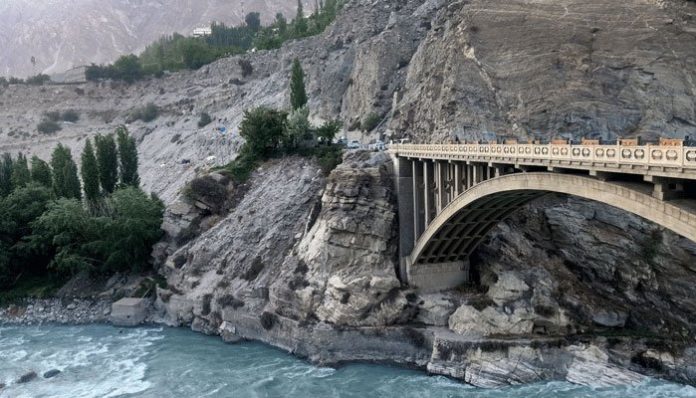About three weeks back, the Shishper Glacial Lake Outburst (GLOF) played havoc with infrastructure yet again. This time the disaster destroyed a part of the Hassanabad Bridge in the Hunza valley, another small bridge and two small hydro power plants and other infrastructures, and natural habitats on the way downstream. The disaster hit the headlines and yet, just in three weeks, the same lazy routine goes on in the offices of the concerned authorities in the federal capital.
It is good that the Shishper GLOF cost no life. The Gilgit-Baltistan Disaster Management Authority (GBDMA) informed the locals well in time, and helped them move out to safer places. But, still damage to their properties were reported. The Shishper GLOF first occurred in May 2018. It has been an annual phenomenon since then. There are some other glacial lakes too in Gilgit-Baltistan and Chitral, ticking bombs that can explode in minutes.
Remember the annual floods in the highland valleys of Chitral and Gilgit-Baltistan in summer and monsoon seasons. Flash floods wash away infrastructures and properties of billions. Unfortunately, we could not evolve sustainable or lasting solutions to avert summer GLOF and flash floods despite huge national and international funding in the last twelve years.
The outburst of any of the potentially hazardous lakes can cause a disaster sweeping away everything on its route downstream. We have seen it many times in the past years. One GLOF event can release millions of cubic metres of water and debris, which can cause damages to livelihoods, property and infrastructure. A UNDP-GoP report mentions that over 7.1 million people in GB and Khyber Pakhtunkhwa are vulnerable to such GLOF events while we have yet to count the downstream vulnerability from a GLOF disaster. The GLOF-I project claimed that the project supported communities to prepare for disaster mitigation through Early Warning Systems (EWS), enhanced infrastructure and community-based Disaster Risk Management.
At present, Pakistan’s federal government is implementing a Green Climate Fund (GCF) project worth $38 million for the “Scaling-up of Glacial Lake Outburst Floods Risk Reduction in Northern Pakistan (GLOF-II)”. Kicked off in March 2017, the completion date of the project was extended from 2021 to December 2023.
The project well-handled the widespread debate on the selection of 10 valleys in Gilgit-Baltistan to kick off the interventions. The conflict consumed a lot of time but the technical support of UNDP and Pakistan Meteorological Department played a key role in developing a criteria for the selection of the valleys to start working in. The open-merit policy based on scientific knowledge and technical assessment paved a path for ownership and smooth sailing of the interventions in the selected valleys. Local communities, experts and public institutions had been the backbone of the technical assessment.
According to the project document, it will benefit 29 million people or 15% of the population of Pakistan. Two policies have been reviewed and revised to address the emerging GLOF risks. By the end of the project, about 95% of the households will be able to receive and respond to the early warnings and take appropriate action. At least 250 small-scale engineering structures will be established to reduce the effects of GLOF events on livelihoods. As many as 50 weather monitoring stations and 408 river discharge sensors will be collecting respective data for effective forecasting and planning accordingly to protect life and livelihood. To improve food security and reduce flood risks due to deforestation and inefficient water use, some 65,000 women will be trained in home-gardening; 240 water-efficient farming technologies will be installed and 35,000 hectares of land will be reforested.
All tall claims wash away just in one GLOF disaster – speaking volumes of the “efforts” done and stories of the “struggle” narrated to protect mountain communities, their livelihoods and infrastructures. If the same incompetent practice goes on, it will be hard to find solace for the communities and people living downstream. It will remain a dream to have well-protected mountains, safeguard lives and livelihood of the communities, and protect infrastructures from the impact of GLOF disasters.
Pakistan’s mountains are turning increasingly vulnerable to extreme climatic conditions. So, the risk of GLOFs is increasing. Our mountains are the front lines confronting the brunt of globally rising mean temperature and transboundary carbon emissions. Some other obvious reasons and contributing factors are a fast increasing population, unchecked urbanisation, unsustainable tourism, irrational deforestation and over consumption of natural resources. All have set a terrible recipe for mountain disasters and destruction. No one is bothered about the absence of local remedies that are available but not in place – unfortunately due to vested interests of cartels.
We have witnessed over the years the miseries mountain communities have gone through. The situation at the moment is worse. Torrential rains, flash floods, landslides and the outburst of lakes made of water coming from glacial melt have made human life and livelihood miserable. Capacity building and even some large-scale interventions have not been able to change the situation to the desired level. It is time to rationally review and learn from past interventions and practices.
We have seen many comprehensive climate policies and vigorous action plans coming from the federal government with the participation of the provinces in the last years. International forums and watchdogs have already commended Pakistan’s Climate Action – Sustainable Goal 13. Meanwhile, some international forums have also warned South Asian governments to take measures to safeguard life and livelihood of mountain communities and mountain ecosystems to avoid internal migration which is linked to natural disasters in the mountains.
One major “disaster bomb” is GLOF that our authorities are not taking seriously. A thorough performance audit of GLOF projects’ outcome is needed.

















